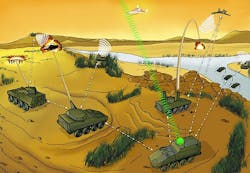Solicitation released for new Marine Corps armored vehicle with open-architecture vetronics
ARLINGTON, Va. – U.S. Navy and Marine Corps researchers are asking industry to build full-scale technology demonstrators of a future reconnaissance armored vehicle to enable Marine battlefield reconnaissance units to fight through the enemy to gather and disseminate crucial intelligence information from the battle front.
Officials of the Office of Naval Research (ONR) in Arlington, Va., released a broad agency announcement Thursday (N00014-19-S-B002) for the Armored Reconnaissance Vehicle (ARV) Technology Demonstrator Design, Fabrication, Test & Demonstration program.
The future ARV will be able to fight for information on a complex and contested battlefield using an automatic rapid-fire medium-caliber cannon, remotely operated medium-caliber machine gun, and open-architecture vetronics to include sensors, communications, and battlefield networking.
The project seeks to build two ARV variants -- a base model and an at-the-edge model to evaluate technologies, performance, and battlefield concepts. Contractors will build two demonstrators of each variant.
The ARV demonstrators must be able to collect mobility data, determine reconnaissance and sensing capabilities, determine unmanned systems integration and operation, evaluate platform lethality, determine platform survivability, and evaluate overall performance.
Technology demonstrators have modular open systems architectures, with an eye to future integration of third-party hardware and software and will enable third-party repair.
The base variant and its vetronics will have an Average manufacturing unit cost of $6 million per platform for 500 units, with initial operating capability (IOC) in 2027.
The ARV is a possible replacement for the U.S. Marine Corps legacy Light Armored Vehicle (LAV). It would support light armored reconnaissance battalions within the Marine divisions.
The vehicle will have new ways to sense and communicate, will be able to destroy heavily armored threats close-in and at range, and will be transportable with the naval expeditionary force by military and commercial trailers, railway, C-17 fixed-wing aircraft, naval amphibious warfare ships and surface connectors, and military sealift command and commercial ships.
The ARV will have persistent surveillance capability using manned and unmanned vehicles; modern command, control, communications, and computers (C4I) vetronics; cross-country and on-road land mobility with shore-to-shore water mobility; passive & active force protection; direct and indirect weapons; be similar size and weight to the legacy LAV; drive-by-wire capability; and a modular interoperable open-systems architecture.
The ARV will identify weapons and targets through obscurants, beyond threat range, and beyond line of sight. It also will be able to transmit sensing and targeting information among the crew, the dismounted scout team, other ARV crews, and other Marine Corps sensors, as well as collect, process, and exploit sensor information and disseminate it to other Marine Corps units.
The ARV also will be able to communicate voice, video, and data where sensors and communications are degraded. Its command and control system will handle weapons fire control; secure voice, video, and data exchanges; battlefield situational awareness in GPS-denied environments; and control unmanned systems beyond line of sight. Its communications network suite also will be able to operate through cyber attacks, and the vehicle will minimize its visual, infrared, RF emissions, radar cross section, and acoustic signatures.
The ARV will be survivable against weapons as large as heavy machine guns, artillery fragmentation rounds, land mines, and improvised explosive devices (IEDs). The Marine Corps is interested in modular and upgradable armor.
The ARV will achieve standoff with active and passive protective systems to sense, orient, classify, track, and defeat incoming rocket-propelled grenades, anti-tank guided missiles, and precision-guided munitions.
Companies interested should submit proposals by 19 Nov. 2018. Contract awards will be on or about 4 March 2019. Email technical questions to the Navy's Jeff Bradel at [email protected]. Email business questions to Justin Fraser at [email protected].
More information is online at https://www.fbo.gov/spg/DON/ONR/ONR/N00014-19-S-B002/listing.html.
Ready to make a purchase? Search the Military & Aerospace Electronics Buyer's Guide for companies, new products, press releases, and videos

